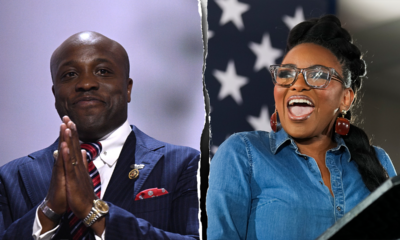Politics
High-tech and war are integrating some ultra-Orthodox Jews into Israel's secular society

Yakob Shoolman spent years studying the Torah, pouring over ancient scripture like many boys in his ultra-Orthodox Jewish neighborhood. He lived a sequestered religious life, marrying early and having four children before he was 30.
But these days Shoolman is learning how to code in a high rise with a view of the sea and a copy of a Steve Jobs biography nearby. His faith remains the center of his identity, but, like a number of students from traditional yeshiva schools, Shoolman wants to join this nation’s vibrant technology industry.
His aspirations come at a time when ultra-Orthodox Jews face increasing resentment from a larger, secular society over religious school subsidies and other benefits, including exemption from compulsory military service for Torah students. Those tensions and a move to limit the role of the Supreme Court led to mass street protests last year as far-right nationalist and religious parties became prominent voices in Prime Minister Benjamin Netanyahu’s coalition government. Many Israelis regard the power that religious parties wield as a threat to civil rights and the country’s democracy.
Students from ultra-Orthodox Jewish communities learn to code to become programmers and software developers at firms like Citibank and Mobileye.
That concern has been eclipsed somewhat as Israelis have united around the war with Hamas and a small but growing number of ultra-Orthodox Jews, known as Haredim, have started to push beyond the bounds of centuries-old tradition. They represent a generational shift that may lead to wider integration of religious conservatives into Israeli life and its economy.
“I don’t believe in separation. The gap between the Haredi and the secular is closing,” said Shoolman, 31, a student at JBH, a school that trains Haredi men to become programmers and software developers at firms like Citibank and Mobileye. “In this school, we’re exposed to many different people. It’s important to understand these worlds.”
He added that the war and an increased reliance on technology since COVID have drawn more ultra-Orthodox Jews out of their enclaves. Haredi have attended shivas for those killed by Hamas and 4,000 have volunteered for temporary emergency service in the army since the war began in October.
But moderates and secularists view such limited integration as hardly notable when Netanyahu’s government is increasing spending on Haredi projects. The government coalition’s discretionary spending for yeshiva schools — which teach little science or math — rose from $322 million in 2022 to $456 million in 2023. Hundreds of millions of dollars more have been allocated for cultural, religious and education programs, along with thousands of government funded jobs that benefit the ultra-Orthodox.
Haredim account for about 13% of Israel’s population of more than 9 million, but their average family size of about seven children is a drain on social welfare spending. The Israeli media have reported that poverty and low employment among Haredim could lead to a 16% tax increase on working Israelis and cost the nation’s economy $2 trillion over the next 40 years.
Students take a break between classes where they learn how to code and program. Ultra-Orthodox Jews face growing resentment from a larger, secular society over religious school subsidies and other benefits.
“The Haredim are the cornerstone to the clash of religion and state,” said Rabbi Uri Regev, head of Hiddush, an organization that advocates for religious freedom and equality. “This problem predates Netanyahu. All previous governments bent to the will of the Haredim.”
He added that the ultra-Orthodox, about 45% of whom are poor, “are a great weight and burden on society.”
”
A 2023 survey done by Hiddush before the war found that 70% of Jews in Israel believe the country’s “most acute internal conflict” is between ultra-Orthodox and secular Jews. The study showed that those fault lines were deep when it comes to military and educational issues: 78% opposed a blanket exemption on military service for ultra-Orthodox and 69% of Jews “support complete cancellation or a significant cut in funding” for yeshiva schools. That latter figure jumps to 93% for secular Jews.
Some fear the Haredim and the extreme right Religious Zionist Party could upset the Middle East and further damage prospects for peace with the Palestinans. Best-selling author and scholar Yuval Noah Harari wrote an essay in July in the left-leaning Haaretz newspaper under the headline: “What will happen to Judaism if Israeli democracy is destroyed by supremacist zealots?” He warned of “spiritual destruction” if a “messianic state” arises to persecute “Arabs, secular people, women and LGBTQ people.” What, he asked, “if that state were to embrace a racist ideology of Jewish supremacy?”
Haredim believe that God’s will shapes all destinies and that their devotion protects the state of Israel. They have long lived in segregated neighborhoods like Mea Shearim in Jerusalem and Bnei Brak near Tel Aviv. Men wearing side curls and black hats walk with sacred books to religious schools while Haredi women are the main breadwinners and child-care providers. Their large families gather on the Sabbath to stroll amid closed shops and quieted tram lines.
This portrait was resonant in the TV series “Shtisel”, about a Haredi father and his artistic son as they confronted nosy neighbors and matchmakers on cloistered streets while navigating the clamor and temptations of an encroaching outside world. The show was widely popular in Israel and provided a common ground that — for less than an hour each night — went beyond suspicions and stereotypes to give secular Jews a glimpse of a world few were intimate with.
Students at JBH, a school that trains Haredi men to become programmers and software developers, take a break and play a video game between classes.
“The other side needs to know that we are Israelis just like everyone else,” said Yitzhak Pindrus, a Knesset member of the ultra-Orthodox party United Torah Judaism, who blamed employers and the army for not doing more to integrate the Haredi. “We have a different culture and different traditions, but you don’t always need to come down on us.”
Computer students like Shoolman, whose wife founded a virtual reality production company, aspire to modern lifestyles and bigger incomes. That desire, however, is considered a threat by religious conservatives who worry such enticements may lead to liberal beliefs around marriage and civil rights — Haredi leaders have long opposed women praying at the Western Wall — and pull the young away from their faith.
“The Haredim are concerned that a person will become his work,” said Aaron Fruchtman, vice president of JBH, which has trained 500 Haredim since 2013, many of whom received government funds and private donations for tuition. “The question is, ‘How do we get a Haredi guy into the Israeli Defense Forces or into high-tech without him losing his religious identity?’ The Haredi idea is first you’re a servant of God, a Torah Jew. But integration in the workforce will break down barriers.”
The early days of Shoolman’s training were difficult. Like most students from yeshiva schools, Shoolman, whose family income is too high to receive public subsidies, knew no English and only a little math. “You’re starting from zero,” he said. “Literally from A,B,C.” He added that since the start of the pandemic, more younger Haredi have turned to technology, using email and rabbi-approved smartphones. His long hours of studying the Torah for years, he said, will help him with the rigors of coding and software.
“We have the ability to sit and learn and be dedicated,” Shoolman said as students played video game tennis on a big screen while others typed on keyboards. “The process of change is speeding up.” He tried to express the contradiction — the navigating of two unreconciled worlds— by joking, “I’m a mainstream, hardcore Haredi.”
The war with Hamas has led other Haredim into the military. Rabbi Ram Moshe Ravad, a Haredi who served for 29 years and retired as a lieutenant colonel and chief rabbi for the Air Force, helped enlist Haredi volunteers for short service after Oct. 7. Most had studied in yeshiva until age 26, which had allowed them military exemptions. Some volunteers went into basic training but many took nonfighting roles like mechanics, cooks and drivers.
“The Haredim are not against the army,” Ravad said. “What’s happened over the years, especially the last few years, is people have been coming out against Haredim. All these [political] movements were saying that Haredim are against the army. So the Haredim avoided serving in the army. Now we’ve come with a different approach. Whoever wants to learn the Torah should learn, and whoever isn’t learning should come [to the army].”
“The Haredim are concerned that a person will become his work,” said Aaron Fruchtman, vice president of JBH, which has trained 500 Haredim since 2013. “The question is, ‘How do we get a Haredi guy into the Israeli Defense Forces or into high-tech without him losing his religious identity?’ ”
Chemi Trachtenberg is a 21-year-old Haredi who enlisted three years ago. “It doesn’t matter if you like Bibi [Netanhayu] or not, if you like the Haredim or not,” he recently told the Jewish Telegraphic Agency, an international news service. “At the end of the day they [Hamas] want to kill us and we need prayers and weapons.”
The “Israelization” of the younger generation “of Haredim was already well underway when this war began,” Anshel Pfeffer wrote in a November opinion column in Haaretz. “It was only natural that those who were already less committed to cutting themselves off from society would feel shame as they saw hundreds of thousands of men and women their age being called up on the day of the [Hamas] massacre.”
He added: “For now, though, they remain a minority in their community. Aside from praying for Israel’s salvation, most of the Haredi groups have continued life as before.”
Regev, the rabbi, said to suggest the ultra-Orthodox are joining society is “an overly rosy characterization” when so many Haredim don’t have well-rounded educations that would benefit the nation’s economy. “The Haredi’s attitude of spiritual strengthening is anathema to the larger secular society,” he said, adding that the ultra-Orthodox oppose secular marriage, civil rights and using public transportation on the Sabbath. “They rely on the public coffers to perpetuate their own poverty.”
Regev said Israel faces two existential questions: the relationships between religion and state, and between Jews and Arabs. The one between religion and state, he said, often appears irreconcilable as the ultra-Orthodox place the sacred above the temporal even when it comes to immediate threats — from COVID to war — against Israel’s future.
Pindrus, the legislator, disagreed: “Haredim are part of the State of Israel,” he said. “What hurts the State of Israel hurts Haredim. Right now we’re in a period of pain, and we’re all feeling this pain.”

Politics
FBI ousts reinstated whistleblower over unauthorized media talks, ‘poor judgment’

NEWYou can now listen to Fox News articles!
A former FBI agent and COVID-era whistleblower who was recently reinstated under President Donald Trump was fired Friday, according to a report.
The FBI dismissed Steve Friend for “unprofessional conduct and poor judgment,” according to a copy of the termination letter posted on X by New York Post columnist Miranda Devine. An FBI source confirmed the firing, but would not elaborate, c biting that it is a personnel matter.
The FBI stated in the letter that Friend “participated in unauthorized interactions with the media, publicly disseminated media sources, and commented publicly on FBI matters and ongoing FBI investigations.”
HOUSE REPUBLICANS ACCUSE BIDEN’S FBI OF RETALIATING AGAINST WHISTLEBLOWER WHO EXPOSED MISCONDUCT
Whistleblowers and former FBI special agents Garret O’Boyle and Steve Friend testified before Congress, Thursday, May 18th. (Alex Wong/Getty Images)
Friend was first suspended by the FBI in August 2022 and resigned in February of 2023. He was reinstated last September.
In the letter, the FBI stated that in November, Friend “disseminated media sources and photographs identifying an alleged subject and discussed the alleged subject on your podcast, despite the lack of credible, verifiable evidence necessary to publicly identify the subject.”
When reached for comment by Fox News Digital, Friend said his ouster was retaliation by FBI Director Kash Patel.
EX-FBI AGENTS SAY BUREAU USED INTERNAL PROBES TO PUNISH WHISTLEBLOWERS
Steve Friend, a former Federal Bureau of Investigation (FBI) agent and COVID-era whistleblower who was recently reinstated was fired Friday, according to a report. (Getty Images/Fox News Digital)
Friend’s dismissal from the Bureau came after his attorneys at Empower Oversight Whistleblowers & Research dropped him as a client on Dec. 5.
The non-profit organization said in a letter to Friend that he had ignored its advice by commenting publicly on FBI matters, “risking further adverse administrative action” by the Bureau.
CLICK HERE TO DOWNLOAD THE FOX NEWS APP
The FBI fired whistleblower Steve Friend on Dec 12, according to a report. (BRENDAN SMIALOWSKI/AFP )
“In light of your apparent unwillingness to follow the free professional advice we have given you, we are even more convinced that our previously expressed inability to represent you regarding any legal matters other than your reinstatement was warranted,” the non-profit wrote. ” We are no longer willing or able to expend further time and resources representing your interests or providing counsel moving forward.”
Politics
Times Investigation: Ex-Trump DOJ lawyers say ‘fraudulent’ UC antisemitism probes led them to quit

Nine former Department of Justice attorneys assigned to investigate alleged antisemitism at the University of California described chaotic and rushed directives from the Trump administration and told The Times they felt pressured to conclude that campuses had violated the civil rights of Jewish students and staff.
In interviews over several weeks, the career attorneys — who together served dozens of years — said they were given the instructions at the onset of the investigations. All nine attorneys resigned during the course of their UC assignments, some concerned that they were being asked to violate ethical standards.
“Initially we were told we only had 30 days to come up with a reason to be ready to sue UC,” said Ejaz Baluch, a former senior trial attorney who was assigned to investigate whether Jewish UCLA faculty and staff faced discrimination on campus that the university did not properly address. “It shows just how unserious this exercise was. It was not about trying to find out what really happened.”
In spring 2024, increasingly tumultuous protests over Israel’s war in Gaza racked UCLA. Jewish students and faculty reported “broad-based perceptions of antisemitic and anti-Israeli bias on campus,” a UCLA antisemitism task force found. A group later sued, charging that UCLA violated their civil rights, and won millions of dollars and concessions in a settlement.
UCLA avoided trial, but the suit — along with articles from conservative websites such as the Washington Free Beacon — formed a basis for the UC investigations, the former DOJ lawyers said.
“UCLA came the closest to having possibly broken the law in how it responded or treated civil rights complaints from Jewish employees,” Baluch said. “We did have enough information from our investigation to warrant suing UCLA.” But Baluch said, “We believed that such a lawsuit had significant weaknesses.”
“To me, it’s even clearer now that it became a fraudulent and sham investigation,” another lawyer said.
A DOJ spokesperson did not respond to a request for comment. When it announced findings against UCLA in late July, Assistant Atty. Gen. Harmeet K. Dhillon — the DOJ civil rights chief — said the campus “failed to take timely and appropriate action in response to credible claims of harm and hostility on its campus.” Dhillon said there was a “clear violation of our federal civil rights laws.” Atty. Gen. Pam Bondi said UCLA would “pay a heavy price.”
The former DOJ attorneys’ description of their Trump administration work offers a rare view inside the government’s UC probe. For months, university officials have said little publicly about their ongoing talks with the DOJ. Their strategy has been to tread cautiously and negotiate an out-of-court end to the investigations and financial threats — without further jeopardizing the $17.5 billion in federal funds UC receives.
Four attorneys said they were particularly troubled by two matters. First, they were asked to write up a “j-memo” — a justification memorandum — that explained why UC should face a lawsuit “before we even knew the facts,” one attorney said.
“Then there was the PR campaign,” the attorney said, referring to announcements beginning with a Feb. 28, 2025, press release saying investigators would be visiting UCLA, UC Berkeley, USC and seven other universities nationwide because the campuses “have experienced antisemitic incidents since October 2023.”
“Never before in my time across multiple presidential administrations did we send out press releases essentially saying workplaces or colleges were guilty of discrimination before finding out if they really were,” said one attorney, who requested anonymity for fear of retaliation.
Jen Swedish, a former deputy chief on the employment discrimination team who worked on the UCLA case, said “virtually everything about the UC investigation was atypical.”
“The political appointees essentially determined the outcome almost before the investigation had even started,” said Swedish, referring to Trump administration officials who declared publicly that punishing colleges for antisemitism would be a priority. She resigned in May.
The lawyers spoke out because their formal connections to the DOJ recently ended. Many said they believed the Trump administration had compromised the integrity of the department with what they viewed as aggressive, politically motivated actions against UC and other elite U.S. campuses.
“I think there were absolutely Jewish people on campuses that faced legitimate discrimination. But the way we were pushed so hard to investigate, it was clear to so many of us that this was a political hit job that actually would end up not helping anyone,” said one attorney who worked on UC Davis and UCLA and interviewed students.
In a statement, a UC spokesperson said, “While we cannot speak to the DOJ’s practices, UC will continue to act in good faith and in the best interests of our students, staff, faculty, and patients. Our focus is on solutions that keep UC strong for Californians and Americans.”
The government has not sued UC.
But in August, the DOJ demanded that the university pay a $1.2-billion fine and agree to sweeping, conservative-leaning campus policy changes to settle federal antisemitism accusations. In exchange, the Trump administration would restore $584 million in frozen grant funding. At the time, Gov. Gavin Newsom called the proposal “extortion.”
Last month, after UC faculty independently sued, U.S. District Judge Rita F. Lin ruled that the “coercive and retaliatory” proposal violated the 1st Amendment. Lin blocked the fine and the demands for deep campus changes.
“Agency officials, as well as the president and vice president, have repeatedly and publicly announced a playbook of initiating civil rights investigations of preeminent universities to justify cutting off federal funding, with the goal of bringing universities to their knees and forcing them to change their ideological tune,” Lin said.
Her ruling does not preclude UC from negotiating with the administration or reaching other agreements with Trump.
Protests roiled campuses in spring 2024
The federal investigations largely focused on the tumultuous pro-Palestinian campus protests that erupted at UC campuses. On April 30, 2024, a pro-Israel vigilante group attacked a UCLA encampment, resulting in injuries to student and faculty activists. Police failed to bring the situation under control for hours — a melee former Chancellor Gene Block called a “dark chapter” in the university’s history.
During the 2023-24 UC protests, some Jewish students and faculty described hostile climates and formal antisemitism complaints to the schools increased. Some Jews said they faced harassment for being Zionists. Others said they encountered symbols and chants at protests and encampments, such as “From the river to the sea, Palestine will be free,” which they viewed as antisemitic. Jews were also among the leading encampment activists.
In June 2024, Jewish UCLA students and faculty sued UC, saying the encampment blocked them from accessing Dickson Court and Royce Quad. The four blamed the university for anti-Jewish discrimination, saying it enabled pro-Palestinian activists to protest. On July 29, 2025, UC agreed to pay $6.45 million to settle the federal suit.
In response to the demonstrations and suit, UC overhauled its free speech policies, banning protests that aren’t preapproved from vast portions of campus. It said it would strictly enforce existing bans on overnight encampments and the use of masks to hide identity while breaking the law, and agreed to not prohibit campus access to Jews and other legally protected groups.
Inside the investigations
The nine former DOJ lawyers worked between January and June researching whether UC campuses mishandled complaints of antisemitism filed by Jewish students, faculty and staff tied to pro-Palestinian encampments. They were involved with two areas under the DOJ’s Civil Rights Division — employment litigation and educational opportunities — tasked with looking into potential discrimination faced by UC employees and students.
The attorneys described an at times rushed process that concentrated legal staffing on probing antisemitism at UC campuses, to the detriment of other discrimination cases focused on racial minorities and people who are disabled.
At one point, attorneys said, more than half of the dozens of lawyers in the employment litigation section were assigned solely or nearly exclusively to UC campuses, with some told specifically to research the UCLA David Geffen School of Medicine and other campus divisions. As lawyers begin to quit, the attorneys said, additional staff was brought in from other DOJ teams — those focused on tax law and immigrant employment law.
When five lawyers in the mid-spring reported minimal findings at Berkeley, Davis and San Francisco campuses, they were reassigned to UCLA.
“It was like UCLA was the crown jewel among public universities that the Trump administration wanted to ‘get,’ similar to Harvard for privates,” said another attorney, who requested anonymity because they feared retaliation for speaking out. “There were meetings where managers — who were career employees like us — would convey that political appointees and even the White House wanted us all on UCLA.”
Dena Robinson, a former senior trial attorney, investigated Berkeley, Davis and Los Angeles campuses.
“I was someone who volunteered on my own to join the investigation and I did so because of some of my lived experience. I’m a Black woman. I’m also Jewish,” she said. But she described concerns about fast and shifting deadlines. “And I am highly skeptical of whether this administration actually cares about Jewish people or antisemitism.”
Lawyers described similar views and patterns in the Educational Opportunities Section, where UC investigations were concurrently taking place.
A 10th attorney, Amelia Huckins, said she resigned from that section to avoid being assigned to UC.
“I did not want to be part of a team where I’m asked to make arguments that don’t comport with the law and existing legal precedent,” she said.
Huckins had been away from the job for a little more than two months when she read findings the DOJ released July 29 saying that UCLA acted with “deliberate indifference” to Jewish students and employees and threatened to sue the university if it did not come to a settlement.
In those findings, the DOJ said, “Jewish and Israeli students at UCLA were subjected to severe, pervasive, and objectively offensive harassment that created a hostile environment by members of the encampment.” As evidence, it cited 11 complaints from Jewish or Israeli students regarding discrimination between April 25 and May 1, 2024.
It was “as if they only talked to particular students and used public documents like media reports,” Huckins said, adding that the evidence publicly presented seemed thin. In a “normal investigation,” attorneys research “different layers of document and data requests and interviews at every level of the university system.” Those investigations, she said, can take at least a year, if not longer.
What investigators encountered
Attorneys described site visits at several UC campuses over the spring, including meetings with campus administrators, civil rights officers, police chiefs and UC lawyers who attended interviews — including at least one with UCLA Chancellor Julio Frenk.
The lawyers said UC leaders were cooperative and shared campus policies about how civil rights complaints are handled as well as information detailing the way specific cases were treated, such as those of faculty who said they faced harassment.
“There were thousands and thousands of pages of documents and many interviews,” said Baluch, referring to Berkeley and Davis. “There may have been harassment here and there, but there was not a lot that rose to the level of the university violating federal law, which is a pretty high bar.”
“We identified certain incidents at Berkeley and at Davis that were kind of flash points. There were a couple of protests that seemed to get out of hand. There were the encampments. There was graffiti. But we just did not see a really hostile work environment,” said another attorney who visited those campuses. “And if there was a hostile environment, it seemed to have been remediated by the end of 2024 or even May or June for that matter.”
However, at UCLA, Baluch said he and team members found “problems with the complaint system and that some of the professors were genuinely harassed and to such a severe level that it violates Title VII.” Eventually, he said “we successfully convinced the front office that we should only be going after UCLA.”
Where UC and Trump administration stand today
When Harvard faced major grant freezes and civil rights violation findings, it sued the Trump administration. UC has so far opted against going to court — and is willing to engage in “dialogue” to settle ongoing investigations and threats.
“Our priorities are clear: protect UC’s ability to educate students, conduct research for the benefit of California and the nation, and provide high-quality health care,” said UC spokesperson Rachel Zaentz. “We will engage in good-faith dialogue, but we will not accept any outcome that cripples UC’s core mission or undermines taxpayer investments.”
The calculation, according to UC sources, is simple. They want to avoid a head-on conflict with Trump because UC has too much federal money on the line. They point to Harvard — which suffered major grant losses and federal restrictions on its patents and ability to enroll international students after publicly challenging the president.
“Our strategy before was to lay low and avoid Trump any way we could,” said a UC official, who was not authorized to speak on the record. “After the UCLA grants were pulled and the settlement offer came in, the tactic shifted to ‘playing nice’” without agreeing to its terms.
In public remarks to the board of regents last month at UCLA, UC President James B. Milliken said “the stakes are enormous” and presented data on funding challenges: Under Trump, more than 1,600 federal grants have been cut. About 400 grants worth $230 million remained suspended after faculty court wins.
UC “is still facing a potential loss of more than a billion dollars in federal research funding,” Milliken said.
“The coming months may require even tougher choices across the university,” he said.
No information about a possible UC-Trump settlement has been released. But some former DOJ lawyers said they believe a settlement is inevitable.
“It’s devastating that these institutions are feeling pressured and bullied into these agreements,” said Huckins, speaking of deals with Columbia, Brown, Cornell and other campuses. “I would love it if more schools would stand up to the administration … I recognize that they’re in a hard spot.”
To Baluch, who worked on the UCLA case, it appeared that the DOJ had the upper hand.
“Cutting grants is a huge hit to a university. And the billion-dollars fine is a lot. I see why these universities feel backed into a corner to settle,” he said. “The threats, they are working.”
Politics
Inside Minnesota’s $1B fraud: fake offices, phony firms and a scandal hiding in plain sight

NEWYou can now listen to Fox News articles!
MINNEAPOLIS, MN – As a massive fraud scheme costing state and federal taxpayers at least $1 billion dollars continues to unfold in Minnesota, Fox News Digital visited several locations that received funding through programs like Feeding Our Future and found several inconsistencies exposing the depth of the scandal.
The now-infamous Griggs-Midway Building housed an “unusual concentration” of fraudulent entities involved in the HSS scheme, according to Acting U.S. Attorney Joseph H. Thompson.
Twenty-two “businesses” connected to the HSS program were registered to this single location. Thompson described these entities as “purely fictitious companies solely created to defraud the system.”
These 22 fraudulent businesses collectively billed Medicaid for a staggering $8 million between January 2024 and May 2025.
OMAR ACCUSED BY GOP OPPONENT OF OPENING UP THE DOOR TO MASSIVE MINNEAPOLIS FRAUD: ‘DEEP, DEEP TIES’
An in-person investigation by Fox News Digital of the building, located in St. Paul, Minnesota, showed huge swaths of the southern side of the building completely abandoned. A black and white banner advertising open spaces in the building was adorned atop the “Griggs-Midway Building” sign.
Several men sat together and engaged in conversation at the building entrance. When approached, the men told Fox News Digital that they did not speak English.
However, the western side of the building housed a number of seemingly legitimate businesses on the first floor, including a hair salon, a financial support and loan service for African immigrants and a property management office.
The Griggs-Midway building has become a focal point of the Minnesota HSS fraud scandal. (Nikolas Lanum/Fox News Digital)
Following extensive FBI searches of the building, the Minnesota Department of Human Services conducted approximately 40 investigations into providers associated with the larger Griggs-Midway building.
Brilliant Minds Services allegedly submitted over $2.3 million of the $8 million in fraudulent claims from the Griggs-Midway location, ranking as one of the state’s highest-billing HSS providers last year.
Four defendants, Moktar Hassan Aden, 30; Mustafa Dayib Ali, 29; Khalid Ahmed Dayib, 26; Abdifitah Mohamud Mohamed, 27, were charged in the fraud case. Mohamed was the owner of one of the other fraudulent businesses implicated, Foundation First Services LLC.
‘HE HAD YEARS TO STOP THIS’: GOP LAWMAKERS BLAST WALZ OVER MASSIVE MINNESOTA FRAUD SCHEME
Another false claim location took Fox News Digital to a second-story walkup above a sushi shop just blocks away from the Mississippi River.
The entryway was locked, and it was unclear whether the fraudster simply utilized the address to keep distance, or if the fraudster was actually located at the unit number listed on the claim.
The second floor showed little sign of life. Though one window displayed a “No Kings, No Fascists” sign facing out onto the snowy city street.
A large uniform reddish-brown brick building known as “Winsor Plaza” was the next destination of Fox News Digital’s trek through a brewing Minnesota snowstorm.
The simple, box-like form of the building was centered by a red canopy protruding from the structure’s primary entrance. A white-water tower with “Roseville” painted in red letters rose in the distance through the fog. Inside, a directory showed dozens of legitimate businesses, including doctors’ offices and wealth management services.
A search through the quiet halls of 1935 W County Road gave way to confusion. Unit 150, the office space listed on the false claim, was nowhere to be found. It appeared that in the building’s current configuration the suite simply did not exist. Not only was the claim fraudulent, so was the address.
A similar situation occurred at 9120 Baltimore St N. The claims report noted that the fraudulent entity was operating out of suite 100. Upon arrival, 9120 was seen affixed to a stone pillar in the center of a business parking lot.
However, there was no conglomerate of office spaces or apartment units, no numbers affixed to different storefronts. Only a singular, operational dental office. Another apparent fraudulent address.
NorthPark Dental in Blaine, Minnesota, appears to be a legitimate, operational business. There is no Unit 100 at this location, suggesting that the alleged fraud entity gave a fake address. (Nikolas Lanum/Fox News Digital)
The trend was broken at the next two locations.
2756 Douglas Dr N is a commercial address in Crystal, Minnesota, housing businesses like Rock Bridge Counseling & Mental Health and All Kind Painting & Cleaning, offering services for teens in crisis and home improvement, respectively.
These two businesses comprise suites A and B of the building but were not the fraudulent entities listed on location claims. A real building, with real businesses, but a fake company that appeared to never exist in that space.
MINNESOTA LAWMAKERS VOW NEW CRACKDOWN AFTER $1B FRAUD MELTDOWN THEY SAY WALZ LET SPIRAL
Another stop, 1541 Como Ave, was found inside a narrow St. Paul, Minnesota alleyway. The address housed a small, rusted garage affixed to the back of a church. The garage appeared vacant, with no mailbox or garbage cans.
A picnic bench just outside the garage door was covered in leaves, snow and other debris.
Several gentlemen inside a nearby local business told Fox News Digital that a man named “John” had used the location for a small pop-up gym and fitness center. He was often seen driving around in a fancy car. There was no indication as to whether this location was the legitimate operation center of the fraudulent claim.
4601 E 54th St, another location tied to the scandal, was visited by Fox News Digital only to find an empty parking lot. The address listed was in the 400s on the street. However, there are no 400s on that street, only 500s.
Another location, 2720 E Lake St, was completely boarded up and covered in graffiti with a homeless individual sleeping out front. The building appeared to have been inoperable for a long period of time.
CLICK HERE TO DOWNLOAD THE FOX NEWS APP
“Most of that $500 million hasn’t served a single meal and some of the simple things are if they would have just gone to the facilities, you know, you hear of the thousands of people being served out of an apartment twice a day, all they would have to do is show up and look at it,” Minnesota Republican state Sen. Mark Koran told Fox News Digital about the fraud that was hiding in plain sight in Minneapolis.
“There was an legislative auditor report that showed that 30 property owners where these businesses claim to operate out of, contacted the Department of Education who manage it, who managed that program, and they told them one, the businesses don’t exist in their facilities, so they don’t exist, period, and one of them I think was a city park,” Koran said.
“And so the Department of Education gave that complaint to the nonprofit Feeding Our Future to address those issues and the Department of Education continued to pay millions to those thirty with a blatant, simple process of ‘we’ve been notified they don’t exist’ and they rejected and ignored it.”
-

 Alaska1 week ago
Alaska1 week agoHowling Mat-Su winds leave thousands without power
-

 Texas1 week ago
Texas1 week agoTexas Tech football vs BYU live updates, start time, TV channel for Big 12 title
-
Ohio1 week ago
Who do the Ohio State Buckeyes hire as the next offensive coordinator?
-

 Washington5 days ago
Washington5 days agoLIVE UPDATES: Mudslide, road closures across Western Washington
-

 Iowa7 days ago
Iowa7 days agoMatt Campbell reportedly bringing longtime Iowa State staffer to Penn State as 1st hire
-

 Miami, FL1 week ago
Miami, FL1 week agoUrban Meyer, Brady Quinn get in heated exchange during Alabama, Notre Dame, Miami CFP discussion
-

 Cleveland, OH7 days ago
Cleveland, OH7 days agoMan shot, killed at downtown Cleveland nightclub: EMS
-
World6 days ago
Chiefs’ offensive line woes deepen as Wanya Morris exits with knee injury against Texans



















